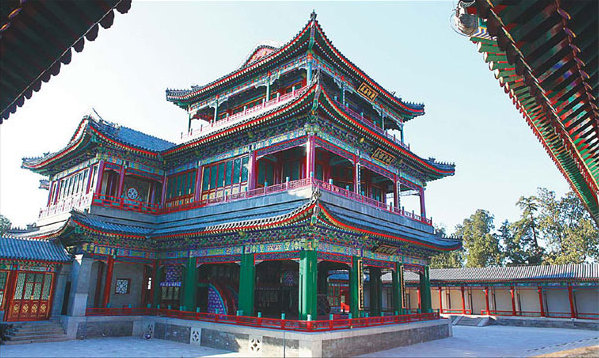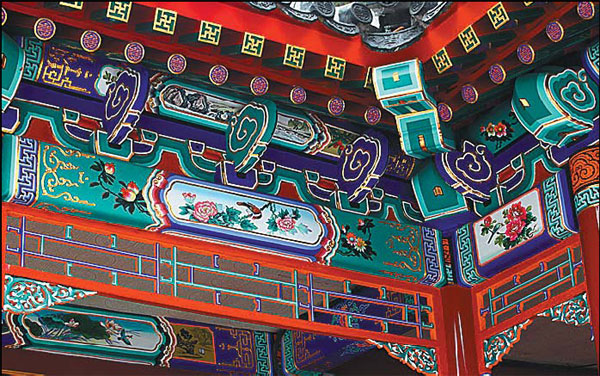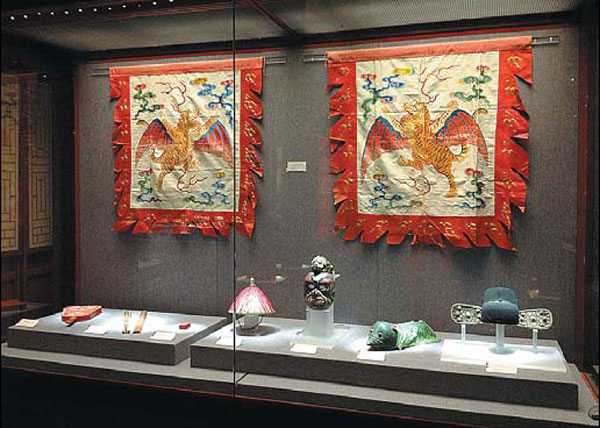Imperial delight
Updated: 2013-05-22 05:38
By Zhang Zixuan (China Daily)
|
||||||||
|
The three-story theater takes on a new look after renovation in the Garden of Virtuous Harmony in Beijing's Summer Palace. Provided by the Summer Palace to China Daily |
The Empress Dowager Cixi watched some 260 operas at the grand theater in the Summer Palace. It is now restored to its former glory and opened to the public. Zhang Zixuan checks out the facelift given to one of China's cultural treasures.
For the first time in more than a century, the sound of Peking Opera fills the grand theater in the Garden of Virtuous Harmony (De He Yuan) in the Summer Palace. The biggest opera theater of the Qing (1644-1911) imperial family underwent 18 months of renovation work and is now restored to its former glory during Emperor Guangxu's reign, and opened to the public.
This is the third and largest repair project in terms of scale in the Garden of Virtuous Harmony after the birth of New China in 1949.
"The grand theater stage is one of the four major constructions during Emperor Guangxu's reign (1874-1908), and it is the only original architecture left among the four. The other three are reconstructions after the structures were ruined by fire," says Geng Liutong, ancient architecture expert and chief engineer of the Summer Palace restoration project.
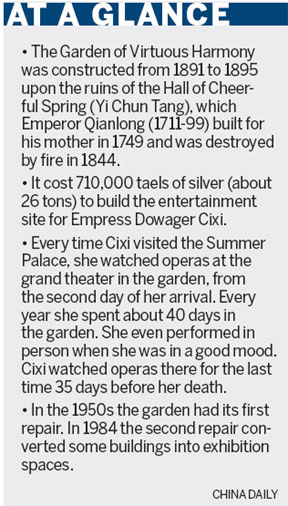
"More importantly, it is a building that did not receive any influence from the West," the 74-year-old stresses.
Constructed from 1891 to 1895, the grand theater in the Garden of Virtuous Harmony was specially built for the 60th birthday of Empress Dowager Cixi (1835-1908), who was passionate about Chinese operas, especially Peking Opera.
According to records, there were five draft plans for the construction of the theater, and Cixi examined them all and provided revisions.
With a height of 22.73 meters, the theater stage is the second highest building after the Tower of Buddhist Incense (Fo Xiang Ge) in the Summer Palace.
It is also one of the four major grand theaters of the Qing Court along with Tongle Garden Theater in the Yuanmingyuan Imperial Garden, Qingyin Pavilion in the Summer Mountain Resort at Chengde, Hebei province, and Studio of Unimpeded Sound (Chang Yin Ge) in the Forbidden City.
The three-story theater stage can accommodate more than 100 actors performing simultaneously. It was designed with skylights, pits and pulleys, which can be used for air-and-ground myth plays. There is also a well at the bottom, where water can be drawn onto the stage when needed.
According to the Qing Court's documentation, Cixi watched operas more than 260 times in the garden. Peking Opera masters, such as Tan Xinpei (1847-1917) and Yang Xiaolou (1878-1938) used to perform for her.
The empress dowager used to sit in the Yile Hall, which was opposite the theater stage.
The surrounding porches on both sides were the seats for the ministers. At that time, the "puppet" Emperor Guangxu controlled by the "Dragon Lady" was only allowed to sit in the porch.
In 1953, these porches were modified into exhibiting spaces. They are now reopened and reinstated together with the grand theater.
There will be several performances shown on the theater stage every day, including Peking Opera and court dances, says Qin Lei, director of the cultural heritage department and assistant to director of the Summer Palace.
He says the Summer Palace is also working with the Beijing Peking Opera Institute to create a chronicle play.
"The play will rerun the moments of how Empress Dowager Cixi promoted the development of Peking Opera," Qin says.
Apart from the theater stage and Yile Hall, 22 buildings have been reconstructed, while retaining the original shape and value.
The paintings on the buildings' exterior eaves have been repainted.
The interior silk wallpaper has been recovered. And the hanging tablets, inscribed with words, have been restored.
Five special projects were also accomplished, namely three-dimensional laser scan, acoustic testing, theater deformation monitoring, construction process and historical changes, and imperial opera culture.
The three-dimensional scan is capable of calculating the theater's 12 major pressure points, which are facilitated with testing instruments and data-sensing devices to protect the theater from natural disasters such as extreme weather and earthquake.
The latest restoration work also turned part of the dressing hall behind the theater stage into a museum.
The first exhibition is Empress Dowager Cixi and the Peking Opera Cultural Heritage, which runs until July 25.
The exhibition features 128 Peking Opera-related objects from the Palace Museum, the Summer Palace, the Central Academy of Fine Arts, the National Library and the China First History Archives.
The 67 exhibits from the Palace Museum are mainly costumes, props and long-playing records, some of which trace back to as early as the Emperor Qianlong (1711-99). The costumes are sewn with gold thread, dazzling still after more than a century.
"The theater stage will surely add spiritual elements to the Summer Palace," comments Liu Zhen, director of Opera Research Institute, Chinese Academy of Cultural Heritage.
Contact the writer at zhangzixuan@chinadaily.com.cn.
|
The buildings' eaves are decorated with delicate paintings. Provided by the Summer Palace to China Daily |
|
Above and below: Costumes and props of Peking Opera are displayed in the newly renovated theater. Zhang Zixuan / China Daily |
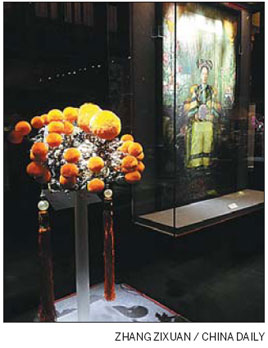
(China Daily 05/22/2013 page19)

 Michelle lays roses at site along Berlin Wall
Michelle lays roses at site along Berlin Wall
 Historic space lecture in Tiangong-1 commences
Historic space lecture in Tiangong-1 commences
 'Sopranos' Star James Gandolfini dead at 51
'Sopranos' Star James Gandolfini dead at 51
 UN: Number of refugees hits 18-year high
UN: Number of refugees hits 18-year high
 Slide: Jet exercises from aircraft carrier
Slide: Jet exercises from aircraft carrier
 Talks establish fishery hotline
Talks establish fishery hotline
 Foreign buyers eye Chinese drones
Foreign buyers eye Chinese drones
 UN chief hails China's peacekeepers
UN chief hails China's peacekeepers
Most Viewed
Editor's Picks

|

|

|

|

|

|
Today's Top News
Shenzhou X astronaut gives lecture today
US told to reassess duties on Chinese paper
Chinese seek greater share of satellite market
Russia rejects Obama's nuke cut proposal
US immigration bill sees Senate breakthrough
Brazilian cities revoke fare hikes
Moody's warns on China's local govt debt
Air quality in major cities drops in May
US Weekly

|

|
